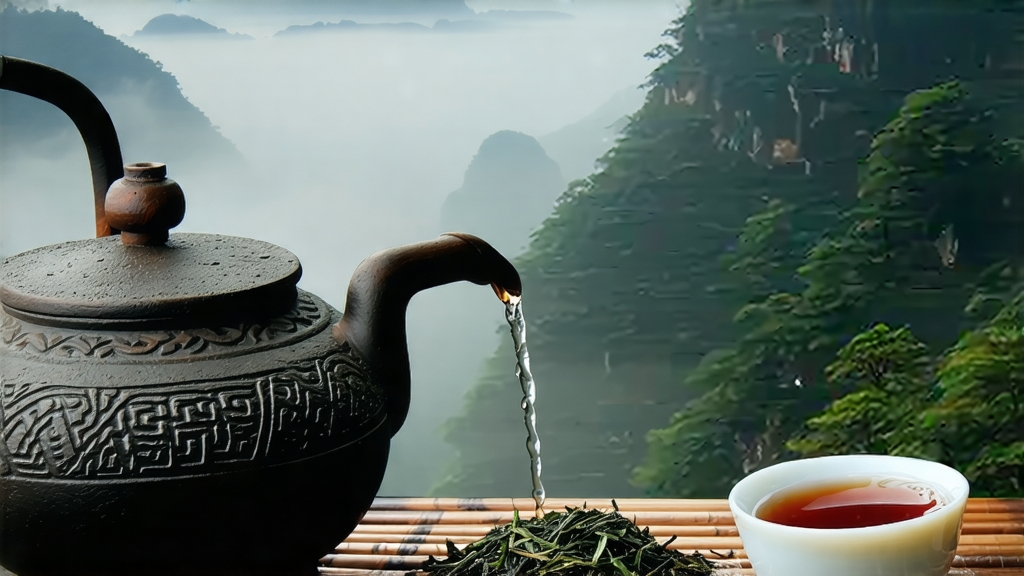
Long before Assam, Ceylon or Earl Grey entered the English lexicon, the words “bohea” and “souchong” were scribbled in the logbooks of 17th-century East India Company captains. They referred to one place—Tongmu Guan on the shoulder of the Wuyi massif in northern Fujian—and to one tea: Lapsang Souchong, the first fully oxidised leaf ever created. Today, when drinkers think of Chinese black tea they often picture malty Yunnan gold tips or brisk Keemun orchid fragrance, yet it is Lapsang Souchong that anchors the family tree. Its story is therefore the story of black tea itself, a narrative woven from imperial edicts, smuggled cuttings, Scottish botanists and the sweet, resinous breath of burning pine.
Historical outline
The exact year is debated, but plantation records kept by the Songluo lineage point to 1568, late in the Ming dynasty, when a passing army forced farmers to abandon freshly picked leaves. To salvage the crop, the leaf was rapidly dried over green pine boughs; the resulting dark, smoky tea found unexpected favour with Dutch traders at the port of Xiamen. By 1604 the first chests reached Europe, where the novelty of a fully red liquor—described as “black” by contrast to green—commanded prices higher than silver. When Catherine of Braganza brought the habit to the English court in 1662, demand exploded. The British East India Company christened the tea “Bohea” (from the Min-dialect “Wuyi”), and for the next two centuries every black tea shipped out of China, whether from Fujian, Anhui or later India, was generically labelled “black” because Lapsang Souchong had defined the category.
Terroir and cultivar
Authentic Lapsang Souchong is protected by both a national origin mark and a UNESCO buffer zone. The core micro-valley, only 60 km², sits at 27° N latitude between 600 m and 1,200 m elevation. Here, a subtropical monsoon climate meets mineral-rich lateritic soil derived from weathered tuff and granite. Fog drifts in from the Jiuqu (Nine-Bend) River, diffusing sunlight into a soft, shifting mosaic that slows photosynthesis and builds amino acids. The indigenous cultivar is Xiao Ye Zhong (“small-leaf species”), a shrub whose narrow, thick leaves contain more geraniol and linalool than the larger-leaf Assamica varieties, giving the finished tea a natural sweet-spice note beneath the smoke.
Two styles, one leaf
Modern commerce has split Lapsang Souchong into two distinct products that share a name but little else.
- Traditional pine-smoke Lapsang: still crafted in Tongmu Guan using the ancient “Qing Lou” (pine smoke house). Fresh leaf is withered over open pinewood fires, pan-fired, rolled, then placed on bamboo trays suspended above smouldering long-root pine and cypress logs. The smoke is cool, 30–35 °C, so the leaf adsorbs volatile phenols—guaiacol, syringol, cresol—without baking. A final firing locks in a fragrance reminiscent of lapsang resin, dried longan and winter campfire.
- Unsmoked “Zheng Shan Xiao Zhong”: a style developed for the modern domestic market that omits the smoke phase. Instead, deeper withering and gentle charcoal baking emphasise cocoa, dried plum and honey nuances. Both styles are protected under the same GI (Geographical Indication), yet they appeal to different palates and brewing protocols.
Craft in slow motion
A visit to Tongmu Guan in late May reveals the choreography. Picking starts at dawn when the dew still weighs down the two-leaf-and-a-bud sets. The leaf is carried in wicker baskets lined with banana leaf to the smoke house, a dark, three-storey cedar structure whose rafters are blackened by decades of resin. Withering lasts 8–10 hours: 70 % indoors on bamboo racks, 30 % outdoors on reed mats, the ratio adjusted daily according to barometric pressure. Rolling is done in 55 cm diameter bamboo drums lined with horsehair cloth; the gentle bruising ruptures 30 % of cell walls, enough for oxidation but not so much that the smoke will overpower. Oxidation itself is